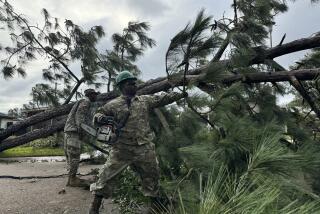Midwest Gets Sun for at Least a Day; Crisis Not Over
ST. LOUIS — New ruptures in a beleaguered levee along a Mississippi River tributary dumped more floodwater Monday into South St. Louis, and 1,000 residents and business owners fled overnight and during the early morning.
Otherwise, conditions in the Midwest seemed to improve--at least for a while. It grew generally sunny, and some forecasters said at least a few relatively dry days were in store. They added, however, that bouts of heavy rain could resume unless overall weather patterns shifted.
More than a month of flooding throughout the area stood as one of the worst natural disasters in American history. The dead numbered 31. Damage estimates ranged to $10 billion. More than 22,000 houses were damaged or destroyed. Estimates of the homeless approached 40,000 people.
The Mississippi River crested overnight at St. Louis without touching the central city. It reached 46.9 feet from river bottom, more than six feet higher than a record flood 20 years ago. But it stopped five feet below the top of the St. Louis flood wall. Then the river began to fall.
In South St. Louis, however, the River Des Peres poured through several ruptures in a levee and flooded to at least 10 feet in one neighborhood before sandbaggers controlled it. As residents fled, hundreds of homes were damaged. Streets buckled, and garbage lined the curbs.
To the northwest, Des Moines residents and small businesses turned on their taps before a flood-swamped water plant was ready. Their actions wrecked efforts to refill the city water mains, dry for more than a week, and set back restoration of water service at least another 24 hours.
The quarter of a million residents of the city, the largest in the nation’s history to lose its water supply, went elsewhere for showers and flush toilets--or did without for the ninth day. Worse, city fire hydrants stayed dry and useless. Tap water safe to drink was still a month away.
Upstream on the Mississippi, a bridge was reopened between Keokuk, Iowa, and Hamilton, Ill., 35 miles north of Quincy, where a bridge was closed late Friday when a levee burst and rampaging water threw a barge into a service station, downed a power line and created a fiery flood.
A second bridge was reopened at Alton, Ill., for 20 minutes every hour, leaving the other 40 minutes car-free for repairs. The two reopened bridges restored auto traffic over the Mississippi in a 250-mile stretch that had been left with nothing but boats, helicopters and small planes to take people and cargo across.
Missouri
In South St. Louis, the River Des Peres swept water the color of chocolate milk against white shingles on the sides of Harvey Lach’s tiny two-bedroom house. Lach is 73. “With this bit of luck,” he said, “I don’t give a damn if I hit 74.”
He was among the 1,000 people who fled as water flooded their homes. They returned to find devastation. Like most of the other residents of a lower-middle class neighborhood that was hardest hit, Lach had no flood insurance. “Never thought you’d need it around here,” he said, eyeing his house with dismay.
But as he surveyed his back yard, which was filled with water, his eye was caught by a bush with several bright pink flowers.
“Well, our flowers finally bloomed in that stinking water,” he said, trying hard to smile. “Maybe I’ll get my wife to come back and look at them. She hasn’t been back here. She just sits at her daughter’s house and cries.”
Around the corner, Al Dickerson, 32, an out-of-work machinist, sat on his porch looking down a hill at another house he owns and had been trying to sell. There was two feet of water on the floor. “I just put $10,000 into that house,” he said. “I’m sure it’s all ruined.”
He, too, had no insurance.
A stone’s throw away was a Monsanto Co. plant, which makes phosphates that are used in cake mixes and toothpaste.
Dickerson and a friend said none of the neighbors believe the company’s claim that no chemicals from the plant seeped into the floodwater. “That’s what they’re saying,” Don Collet, 38, who earns money by doing home improvements, said. “But if you know Monsanto, you know that’s bull.”
Shara Taylor, a spokesperson for Monsanto, said “there is no way” that any chemicals from the plant got into the flood, although parts of the facility were swamped. All of the plant’s inventory, she said, was moved to higher ground before water washed into the facility.
A couple of dozen mom-and-pop businesses in the area were hit by the flood, and Dorothy Horton’s beauty shop was one of them. Her basement was full of water and sewage. “My blood pressure is high as the sky,” she said. “I don’t know how bad it is.”
She worried about the long-term impact on her tiny business, and she has no savings. “This is terrible,” she said, “especially when you have no other means of making a living.”
Horton was one of more than 120 people who applied for help from a Federal Emergency Management Agency center in St. Louis during the first three hours it was open, according to Marty Bahamonde, a spokesman for the agency.
FEMA, which was the target of stinging criticism last year for the way it handled aid claims after a hurricane in South Florida, has been generally praised for efficiency in the Midwest.
“We’ve been out in front of this disaster from the very beginning,” Bahamonde said. “We’ve learned from the mistakes of the past.”
Bahamonde acknowledged that it is easier to manage disaster relief for a flood than for hurricanes or earthquakes because the pace of destruction is slower and more predictable.
“We’ve been able to anticipate,” he said, “when people will need help next.”
He said the first checks from the agency should be arriving in about a week.
Some people, however, fear that they will not get help at all.
“The government’s never done anything for me except draft me,” said Lach, as he looked at his blooming flowers.
“I believe the wealthy farmers are going to get the cream of the relief money.”
In Des Moines, city officials said hundreds, perhaps thousands of people ignored their warning against turning on taps too soon.
They drew at least 500,000 gallons an hour out of the 810 miles of water mains and auxiliary pipes before they should have, setting back the city’s goal of refilling the system step by step with 30 million gallons needed to bring up water pressure.
The city had expected to fill fire mains by Tuesday, and then the rest of the city system. Instead, no residential service is now expected until late Wednesday or even Thursday, according to L. D. McMullen, executive director of Des Moines’ water treatment plant.
“The greed of a few is hurting the masses,” McMullen said.
In a stern warning to abusers, he declared: “If we find a customer using water contrary to our guidance, we will terminate water service to that customer and won’t restore it until after everyone has theirs.”
McMullen said that 50 water service termination notices were handed out to small business and apartment owners--all of them reported to authorities by angry neighbors. He declined to identify the water abusers.
But he warned others who might try to draw water early: “We will know, because the pressure drops.”
Mayor John Dorrian implored: “Please don’t flush those toilets.”
The delay and its cause angered residents growing weary of sponge baths, portable toilets and drinking water hauled to town in stainless steel tanks by the Army National Guard and dispensed at 93 distribution sites.
“We’re getting punished for what someone else is doing!” said Carole Graham, 46, drying her hair in the sun after shampooing in 3-day-old rainwater stored in a garbage can. “It’s not fair. Everybody should follow the same rules so all get justice.”
Lis Harvey, 40, a mail handler, agreed saying, “What is wrong with these people? The city told us to treat that water like gold.”
Other States
Illinois: Rain fed a stream into the Fox River and overflowed an earthen dam. It flooded Algonquin, 50 miles northwest of Chicago and forced the temporary evacuation of 500 residents. Former presidential candidate Ross Perot visited Alton, where he donated $1 million to flood relief and promised an additional $1 million.
North Dakota: In Fargo, meteorologists lowered a flood forecast, and city officials held off building a dike to protect the downtown area. Rain and a rise in the Red River flooded Fargo and its twin city of Moorhead, Minn., last week with water and raw sewage.
More to Read
Sign up for Essential California
The most important California stories and recommendations in your inbox every morning.
You may occasionally receive promotional content from the Los Angeles Times.











